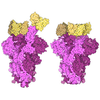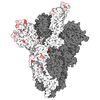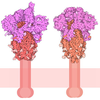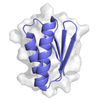[English] 日本語
 Yorodumi
Yorodumi- PDB-9css: Cryo-EM structure of SARS-CoV-2 spike protein Ecto-domain with in... -
+ Open data
Open data
- Basic information
Basic information
| Entry | Database: PDB / ID: 9css | ||||||||||||||||||||||||
|---|---|---|---|---|---|---|---|---|---|---|---|---|---|---|---|---|---|---|---|---|---|---|---|---|---|
| Title | Cryo-EM structure of SARS-CoV-2 spike protein Ecto-domain with internal tag, 1UP RBD conformation | ||||||||||||||||||||||||
 Components Components | Spike glycoprotein | ||||||||||||||||||||||||
 Keywords Keywords | VIRAL PROTEIN / SARS-CoV-2 Spike protein Ectodomain with internal tag | ||||||||||||||||||||||||
| Function / homology |  Function and homology information Function and homology informationMaturation of spike protein / viral translation / Translation of Structural Proteins / Virion Assembly and Release / host cell surface / host extracellular space / symbiont-mediated-mediated suppression of host tetherin activity / Induction of Cell-Cell Fusion / structural constituent of virion / entry receptor-mediated virion attachment to host cell ...Maturation of spike protein / viral translation / Translation of Structural Proteins / Virion Assembly and Release / host cell surface / host extracellular space / symbiont-mediated-mediated suppression of host tetherin activity / Induction of Cell-Cell Fusion / structural constituent of virion / entry receptor-mediated virion attachment to host cell / membrane fusion / Attachment and Entry / host cell endoplasmic reticulum-Golgi intermediate compartment membrane / positive regulation of viral entry into host cell / receptor-mediated virion attachment to host cell / host cell surface receptor binding / symbiont-mediated suppression of host innate immune response / receptor ligand activity / endocytosis involved in viral entry into host cell / fusion of virus membrane with host plasma membrane / fusion of virus membrane with host endosome membrane / viral envelope / virion attachment to host cell / SARS-CoV-2 activates/modulates innate and adaptive immune responses / host cell plasma membrane / virion membrane / identical protein binding / membrane / plasma membrane Similarity search - Function | ||||||||||||||||||||||||
| Biological species |  | ||||||||||||||||||||||||
| Method | ELECTRON MICROSCOPY / single particle reconstruction / cryo EM / Resolution: 2.72 Å | ||||||||||||||||||||||||
 Authors Authors | Singh, S. / Hasan, S.S. | ||||||||||||||||||||||||
| Funding support |  United States, 1items United States, 1items
| ||||||||||||||||||||||||
 Citation Citation |  Journal: J Struct Biol X / Year: 2025 Journal: J Struct Biol X / Year: 2025Title: Production and cryo-electron microscopy structure of an internally tagged SARS-CoV-2 spike ecto-domain construct. Authors: Suruchi Singh / Yi Liu / Meghan Burke / Vamseedhar Rayaprolu / Stephen E Stein / S Saif Hasan /  Abstract: The SARS-CoV-2 spike protein is synthesized in the endoplasmic reticulum of host cells, from where it undergoes export to the Golgi and the plasma membrane or retrieval from the Golgi to the ...The SARS-CoV-2 spike protein is synthesized in the endoplasmic reticulum of host cells, from where it undergoes export to the Golgi and the plasma membrane or retrieval from the Golgi to the endoplasmic reticulum. Elucidating the fundamental principles of this bidirectional secretion are pivotal to understanding virus assembly and designing the next generation of spike genetic vaccine with enhanced export properties. However, the widely used strategy of C-terminal affinity tagging of the spike cytosolic tail interferes with proper bidirectional trafficking. Hence, the structural and biophysical investigations of spike protein trafficking have been hindered by a lack of appropriate spike constructs. Here we describe a strategy for the internal tagging of the spike protein. Using sequence analyses and AlphaFold modeling, we identified a site down-stream of the signal sequence for the insertion of a twin-strep-tag, which facilitates purification of an ecto-domain construct from the extra-cellular medium of mammalian Expi293F cells. Mass spectrometry analyses show that the internal tag has minimal impact on -glycan modifications, which are pivotal for spike-host interactions. Single particle cryo-electron microscopy reconstructions of the spike ecto-domain reveal conformational states compatible for ACE2 receptor interactions, further solidifying the feasibility of the internal tagging strategy. Collectively, these results present a substantial advance towards reagent development for the investigations of spike protein trafficking during coronavirus infection and genetic vaccination. | ||||||||||||||||||||||||
| History |
|
- Structure visualization
Structure visualization
| Structure viewer | Molecule:  Molmil Molmil Jmol/JSmol Jmol/JSmol |
|---|
- Downloads & links
Downloads & links
- Download
Download
| PDBx/mmCIF format |  9css.cif.gz 9css.cif.gz | 699.8 KB | Display |  PDBx/mmCIF format PDBx/mmCIF format |
|---|---|---|---|---|
| PDB format |  pdb9css.ent.gz pdb9css.ent.gz | 473.7 KB | Display |  PDB format PDB format |
| PDBx/mmJSON format |  9css.json.gz 9css.json.gz | Tree view |  PDBx/mmJSON format PDBx/mmJSON format | |
| Others |  Other downloads Other downloads |
-Validation report
| Summary document |  9css_validation.pdf.gz 9css_validation.pdf.gz | 2.7 MB | Display |  wwPDB validaton report wwPDB validaton report |
|---|---|---|---|---|
| Full document |  9css_full_validation.pdf.gz 9css_full_validation.pdf.gz | 2.7 MB | Display | |
| Data in XML |  9css_validation.xml.gz 9css_validation.xml.gz | 95.8 KB | Display | |
| Data in CIF |  9css_validation.cif.gz 9css_validation.cif.gz | 146.9 KB | Display | |
| Arichive directory |  https://data.pdbj.org/pub/pdb/validation_reports/cs/9css https://data.pdbj.org/pub/pdb/validation_reports/cs/9css ftp://data.pdbj.org/pub/pdb/validation_reports/cs/9css ftp://data.pdbj.org/pub/pdb/validation_reports/cs/9css | HTTPS FTP |
-Related structure data
| Related structure data |  45893MC  9b0yC  9b2vC  9ct2C  9cvhC  9cxeC  9n2lC M: map data used to model this data C: citing same article ( |
|---|---|
| Similar structure data | Similarity search - Function & homology  F&H Search F&H Search |
- Links
Links
- Assembly
Assembly
| Deposited unit | 
|
|---|---|
| 1 |
|
- Components
Components
-Protein , 1 types, 3 molecules BCA
| #1: Protein | Mass: 140679.656 Da / Num. of mol.: 3 / Mutation: K986P, V987P, 682-685 RRAR mutated to GSAS Source method: isolated from a genetically manipulated source Details: D614G variant, Internal Streptavidin tag near N-terminus Source: (gene. exp.)  Gene: S, 2 / Production host:  Homo sapiens (human) / References: UniProt: P0DTC2 Homo sapiens (human) / References: UniProt: P0DTC2 |
|---|
-Sugars , 5 types, 46 molecules 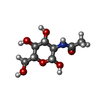
| #2: Polysaccharide | beta-D-mannopyranose-(1-4)-2-acetamido-2-deoxy-beta-D-glucopyranose-(1-4)-2-acetamido-2-deoxy-beta- ...beta-D-mannopyranose-(1-4)-2-acetamido-2-deoxy-beta-D-glucopyranose-(1-4)-2-acetamido-2-deoxy-beta-D-glucopyranose Source method: isolated from a genetically manipulated source #3: Polysaccharide | 2-acetamido-2-deoxy-beta-D-glucopyranose-(1-4)-2-acetamido-2-deoxy-beta-D-glucopyranose Source method: isolated from a genetically manipulated source #4: Polysaccharide | Source method: isolated from a genetically manipulated source #5: Polysaccharide | alpha-D-mannopyranose-(1-4)-2-acetamido-2-deoxy-beta-D-glucopyranose-(1-4)-2-acetamido-2-deoxy-beta- ...alpha-D-mannopyranose-(1-4)-2-acetamido-2-deoxy-beta-D-glucopyranose-(1-4)-2-acetamido-2-deoxy-beta-D-glucopyranose Source method: isolated from a genetically manipulated source #6: Sugar | ChemComp-NAG / |
|---|
-Details
| Has ligand of interest | N |
|---|---|
| Has protein modification | Y |
-Experimental details
-Experiment
| Experiment | Method: ELECTRON MICROSCOPY |
|---|---|
| EM experiment | Aggregation state: PARTICLE / 3D reconstruction method: single particle reconstruction |
- Sample preparation
Sample preparation
| Component | Name: SARS-CoV-2 Spike protein Ectodomain with Internal tag / Type: COMPLEX / Entity ID: #1 / Source: RECOMBINANT |
|---|---|
| Molecular weight | Value: 585 kDa/nm / Experimental value: YES |
| Source (natural) | Organism:  |
| Source (recombinant) | Organism:  Homo sapiens (human) Homo sapiens (human) |
| Buffer solution | pH: 7.5 |
| Specimen | Conc.: 2.5 mg/ml / Embedding applied: NO / Shadowing applied: NO / Staining applied: NO / Vitrification applied: YES |
| Specimen support | Grid material: COPPER / Grid mesh size: 300 divisions/in. / Grid type: Quantifoil R2/2 |
| Vitrification | Cryogen name: ETHANE / Humidity: 100 % / Chamber temperature: 298 K |
- Electron microscopy imaging
Electron microscopy imaging
| Experimental equipment |  Model: Titan Krios / Image courtesy: FEI Company |
|---|---|
| Microscopy | Model: TFS KRIOS |
| Electron gun | Electron source:  FIELD EMISSION GUN / Accelerating voltage: 300 kV / Illumination mode: FLOOD BEAM FIELD EMISSION GUN / Accelerating voltage: 300 kV / Illumination mode: FLOOD BEAM |
| Electron lens | Mode: BRIGHT FIELD / Nominal magnification: 16500 X / Calibrated magnification: 191780 X / Nominal defocus max: 2500 nm / Nominal defocus min: 800 nm |
| Image recording | Electron dose: 43.97 e/Å2 / Film or detector model: TFS FALCON 4i (4k x 4k) |
- Processing
Processing
| EM software |
| ||||||||||||||||||||||||
|---|---|---|---|---|---|---|---|---|---|---|---|---|---|---|---|---|---|---|---|---|---|---|---|---|---|
| CTF correction | Type: PHASE FLIPPING AND AMPLITUDE CORRECTION | ||||||||||||||||||||||||
| 3D reconstruction | Resolution: 2.72 Å / Resolution method: FSC 0.143 CUT-OFF / Num. of particles: 111897 / Symmetry type: POINT | ||||||||||||||||||||||||
| Atomic model building |
| ||||||||||||||||||||||||
| Atomic model building |
| ||||||||||||||||||||||||
| Refinement | Cross valid method: NONE Stereochemistry target values: GeoStd + Monomer Library + CDL v1.2 | ||||||||||||||||||||||||
| Displacement parameters | Biso mean: 36.04 Å2 | ||||||||||||||||||||||||
| Refine LS restraints |
|
 Movie
Movie Controller
Controller








 PDBj
PDBj